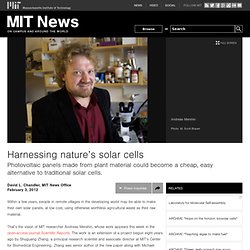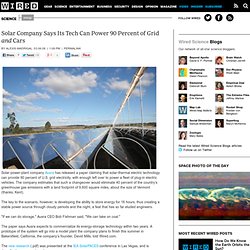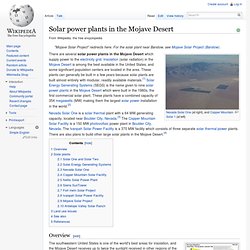

Three-Dimensional Design Leads to Better Solar Cells. A Santa Barbara, California, company called Solar3D plans to make silicon solar cells that are more efficient than conventional cells by borrowing the light-trapping concept behind optical-fiber technology.

The company claims that its three-dimensional design will funnel light into silicon and keep it trapped—giving the material more time to convert it into electricity. Silicon has a theoretical maximum light-to-electricity conversion efficiency of 29 percent, but panels on the market today are only 15 to 18 percent efficient. Solar3D does not have exact efficiency numbers for its design yet, but CEO Jim Nelson says, “We think it’s going to approach silicon’s theoretical efficiency. We won’t get to 29 percent—nobody’s going to get that high with silicon—but we’re hoping to get as close as possible.”
New Solar Panels Produced at Less Than $1 Per Watt. HelioVolt: Solar Innovation Powering a Sustainable World. Harnessing nature’s solar cells. Within a few years, people in remote villages in the developing world may be able to make their own solar panels, at low cost, using otherwise worthless agricultural waste as their raw material.

That’s the vision of MIT researcher Andreas Mershin, whose work appears this week in the open-access journal Scientific Reports. The work is an extension of a project begun eight years ago by Shuguang Zhang, a principal research scientist and associate director at MIT’s Center for Biomedical Engineering. Zhang was senior author of the new paper along with Michael Graetzel of Switzerland’s École Polytechnique Fédérale de Lausanne. In his original work, Zhang was able to enlist a complex of molecules known as photosystem-I (PS-I), the tiny structures within plant cells that carry out photosynthesis.
But that early system had some drawbacks. As an bonus, both zinc oxide and titanium dioxide — the main ingredient in many sunscreens — are very good at absorbing ultraviolet light. Photovoltaics. Photovoltaic SUDI shade is an autonomous and mobile station in France that provides energy for electric vehicles using solar energy.

Photovoltaics (PV) is a method of generating electrical power by converting solar radiation into direct current electricity using semiconductors that exhibit the photovoltaic effect. Photovoltaic power generation employs solar panels composed of a number of solar cells containing a photovoltaic material. Mainstream materials presently used for photovoltaics include monocrystalline silicon, polycrystalline silicon, amorphous silicon, cadmium telluride, and copper indium gallium selenide/sulfide. Due to the increased demand for renewable energy sources, the manufacturing of solar cells and photovoltaic arrays has advanced considerably in recent years. Solar photovoltaics is a sustainable energy source.[1] In 2013, its fast-growing capacity increased by 36% to a running total of 136 GW, worldwide. Quantum dot solar cell.
Spin-cast quantum dot solar cell built by the Sargent Group at the University of Toronto.

The metal disks on the front surface are the electrical connections to the layers below. Quantum dot solar cells are an emerging field in solar cell research that uses quantum dots as the absorbing photovoltaic material, as opposed to better-known bulk materials such as silicon, copper indium gallium selenide (CIGS) or CdTe. Quantum dots have bandgaps that are tunable across a wide range of energy levels by changing the quantum dot size. This is in contrast to bulk materials, where the bandgap is fixed by the choice of material composition.
This property makes quantum dots attractive for multi-junction solar cells, where a variety of different bandgap materials are used to improve efficiency by harvesting select portions of the solar spectrum. Solar Power News. Cool Earth Solar: News Archive. Tamera - SolarVillage.
This Is Why We're Hot: Sun-Absorbing Black Roofs Need a Coat of White Paint - Cities. Solar for your home. Sunrise and Sunset for U.S.A. – Nebraska – Omaha – coming days. Solar Power Rocks! Use Solar Energy to Power your Home, your Business, your LIFE! Your Complete Guide to Solar Energy. Solar Power. Home Page. EERE: Green Power Network Home Page. 2011 Platts Global Energy Awards. Government to slash subsidies for solar power. China's super-rich: Zhu Gongshan. 5 July 2011Last updated at 19:00 ET By Nick Rosen Author and film-maker Zhu Gongshan's company GCL-Poly is now China's largest producer of polysilicon, the main material in solar panels There is little information in the public domain about energy company boss Zhu Gongshan - and one gets the impression he prefers it that way.

While other billionaires invited me to their offices or even their homes, Zhu preferred to talk in a hotel suite hired solely for the occasion. Zhu, 53, is one of the Party Traditionalists, and is not secretive so much as modest - a trait much prized among a certain type of successful businessman in China today. His company GCL-Poly is now China's largest producer of polysilicon, the main material in solar panels, yet despite his $2 billion (£1.24 billion) fortune Zhu seemed uninterested in the luxury brands which motivate so many of the newly-successful Chinese.
Solar Company Says Its Tech Can Power 90 Percent of Grid and Cars. Solar-power-plant company Ausra has released a paper claiming that solar-thermal electric technology can provide 90 percent of U.S. grid electricity, with enough left over to power a fleet of plug-in electric vehicles.

The company estimates that such a changeover would eliminate 40 percent of the country’s greenhouse gas emissions with a land footprint of 9,600 square miles, about the size of Vermont (thanks, Kent). The key to the scenario, however, is developing the ability to store energy for 16 hours, thus creating a stable power source through cloudy periods and the night, a feat that has so far eluded engineers. "If we can do storage," Ausra CEO Bob Fishman said, "We can take on coal. " The paper says Ausra expects to commercialize its energy-storage technology within two years. A prototype of the system will go into a model plant the company plans to finish this summer in Bakersfield, California, the company’s founder, David Mills, told Wired.com. Solar power plants in the Mojave Desert.
There are several solar power plants in the Mojave Desert which supply power to the electricity grid.

Insolation (solar radiation) in the Mojave Desert is among the best available in the United States, and some significant population centers are located in the area. Solar Panels Integrate Into Building Facade. In Helsinki, Norway, Ruukki reports that it has developed what is believed to be the first photovoltaic system to be fully integrated into the facade of a building.

This patented solar power system does not depend on the sun’s warmth, only its radiation (a key factor in cold climates). Ruuki designed this solar panel for applications in conjunction with commercial buildings, providing juice for the building’s needs and feeding excess back onto the grid. The company reports that this new technology is ”the most cost-effective way on the market to make a fully-glazed facade that generates energy from the sun.” image via Ruukki Great, you say, but I live in a cloudy climate. The photovoltaic modules in this system are based on a glazed form of CIGS thin-film technology (Copper Indium Gallium Diselenide) combined with Ruukki’s steel rainscreen panel system.
The facade is pre-designed, and delivery includes all the components and supplies required on site, including the cabling system.